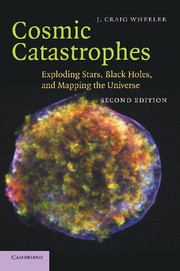Book contents
- Frontmatter
- Contents
- Preface
- 1 Setting the stage: star formation and hydrogen burning in single stars
- 2 Stellar death: the inexorable grip of gravity
- 3 Dancing with stars: binary stellar evolution
- 4 Accretion disks: flat stars
- 5 White dwarfs: quantum dots
- 6 Supernovae: stellar catastrophes
- 7 Supernova 1987A: lessons and enigmas
- 8 Neutron stars: atoms with attitude
- 9 Black holes in theory: into the abyss
- 10 Black holes in fact: exploring the reality
- 11 Gamma-ray bursts, black holes and the Universe: long, long ago and far, far away
- 12 Supernovae and the Universe
- 13 Wormholes and time machines: tunnels in space and time
- 14 Beyond: the frontiers
- Index
1 - Setting the stage: star formation and hydrogen burning in single stars
Published online by Cambridge University Press: 14 September 2009
- Frontmatter
- Contents
- Preface
- 1 Setting the stage: star formation and hydrogen burning in single stars
- 2 Stellar death: the inexorable grip of gravity
- 3 Dancing with stars: binary stellar evolution
- 4 Accretion disks: flat stars
- 5 White dwarfs: quantum dots
- 6 Supernovae: stellar catastrophes
- 7 Supernova 1987A: lessons and enigmas
- 8 Neutron stars: atoms with attitude
- 9 Black holes in theory: into the abyss
- 10 Black holes in fact: exploring the reality
- 11 Gamma-ray bursts, black holes and the Universe: long, long ago and far, far away
- 12 Supernovae and the Universe
- 13 Wormholes and time machines: tunnels in space and time
- 14 Beyond: the frontiers
- Index
Summary
INTRODUCTION
We look up on a dark night and wonder at the stars in their brilliant isolation. The stars are not, however, truly isolated. They are one remarkable phase in a web of interconnections that unite them with the Universe and with us as human beings. These connections range from physics on the tiniest microscopic scale to the grandest reaches in the Universe. Stars can live for times that span the age of the Universe, but they can also undergo dramatic changes on human timescales. They are born from great clouds of gas and return matter to those clouds, seeding new stars. They produce the heavy elements necessary to make not only planets but also life as we know it. The elements forged in stars compose humans who wonder at the nature of it all. Our origin and fate are bound to that of the stars. To study and understand the stars in all their manifestations, from our life-giving Sun to black holes, is to deepen our understanding of the role of humans in the unfolding drama of nature.
This book will focus on the exotica of stars, their catastrophic deaths, and their transfigurations into bizarre objects like white dwarfs, neutron stars, and black holes. This will lead us from the stellar mundane to the frontiers of physics. We will see how stars work, how astronomers have come to understand them, how new knowledge of them is sought, how they are used to explore the Universe, and how they lead us to contemplate some of the grandest questions ever posed.
- Type
- Chapter
- Information
- Cosmic CatastrophesExploding Stars, Black Holes, and Mapping the Universe, pp. 1 - 26Publisher: Cambridge University PressPrint publication year: 2007



